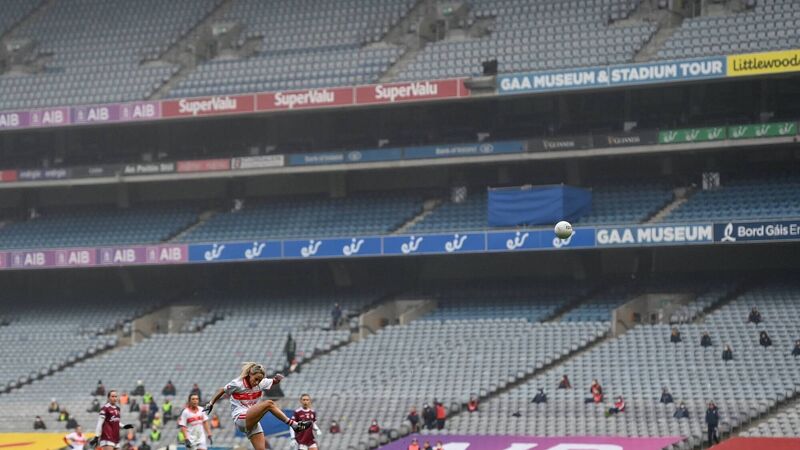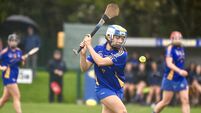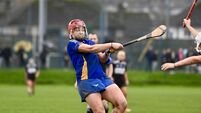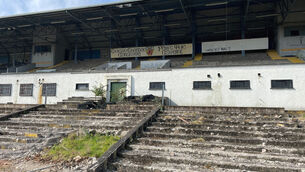Eimear Ryan: Merger the common-sense solution to give our daughters their GAA birthright

Cork's Orla Finn kicks a free during their TG4 All-Ireland Senior Ladies Football Championship semi-final win over Galway at Croke Park. Photo: Ramsey Cardy/Sportsfile
I’ll be honest — I thought the Limerick hurlers should have given over the pitch.
Back in December, when the All-Ireland ladies football semi-final between Cork and Galway was fixed for the Gaelic Grounds, it was on the condition that the Limerick hurlers would not need the pitch for preparation for their own final. But it turned out they did, so the ladies were ousted.
At the time, it struck me as unfair, and indicative of how little respect the women’s games are held in by the GAA at large. An All-Ireland semi-final displaced for a training session, albeit an important one? Ye couldn’t have moved your session by a few hours, lads, or even — god forbid — a day?
In my despair, I thought about how it reflected wider societal trends: how women are socialised to be endlessly accommodating, and how women’s flexibility is taken for granted in a way that men’s rarely is.
It was a little more complicated than that, of course. The Gaelic Grounds was Plan B in the first place, the semi-final having initially been set for late November in Semple Stadium, but switched to December 6th to avoid a fixture clash for Cork’s dual players. (It’s a mystery why the venue was also switched; surely Thurles would have been an option for December 6th also?).
The rest, you know: the game was moved from the Gaelic Grounds to Parnell Park, which was frozen over, and so it was switched last-minute to Croke Park. The game was moved so hastily that a TV broadcast could not be arranged in time, and Galway arrived at the stadium late, giving them little time to prepare. It was, in short, a mess.
The whole affair was a convergence of various factors, not all of which could be helped: the shorter season due to the pandemic, the unsuitable weather conditions. But fixture clashes and venue insecurity are issues that crop up again and again in the women’s codes, and at this stage, it’s hard to see how they can be resolved outside of a merger.
The M-word has been spoken of as a common-sense solution in camogie circles for as long as I can remember. But movement in this direction seems to be glacial. Aogán Ó Fearghail’s report, which explicitly stated the aim of having all Gaelic games under one umbrella by the time of the GAA’s 150th anniversary, has been sidelined for the last couple of years.
Even last year, a motion to facilitate dual players was defeated at both the LGFA and Camogie Association’s annual congresses, to the widespread frustration of players on Twitter. The disconnect between the associations and the players they serve was never more apparent.
There have been some positive recent signs, such as the appointment of Prof. Anne Looney to Coiste Bainistí by incoming GAA president Larry McCarthy. Hopefully, this is the first in a series of appointments that will bring the board’s female representation closer to the government-mandated 30% (At the moment, it languishes at 11%). More female involvement at the top will be central to the necessary cultural changes.
A striking trend in the wake of the semi-final fiasco was how quickly LGFA officials moved to praise the GAA for facilitating them, seeming grateful for any crumbs from the GAA table. Likewise, the incoming LGFA president, Mícheál Naughton, said during the week that "our association would not be in existence if it were not for the men giving us grounds and pitches. For that we are very grateful."
It was a well-meaning statement, made in the broader context of the lack of LGFA-owned venues and his intention to rectify that, but it highlighted how little power the women’s games have in this dynamic.
In theory, if the three associations merged, resources would be allocated equally, and sketchy practices like county boards charging women’s teams for the use of facilities — thereby hoovering up already-scarce funds — would be ended. Sensible fixture calendars, that take into account dual players and feature male/female double-headers, would be drawn up.
It’s an accident of history that things are the way they are. Pretty much every organisation founded in the late 19th century was male-dominated because, in the words of Abe Simpson, it was the style at the time. As women have claimed their social and political freedoms over the last century and a half, those organisations have opened up to embrace and support and be energised by women. At local level, many GAA clubs have.
I’ve been fortunate. Both clubs I’ve played with, Moneygall and the Barrs, have always provided well for their women’s teams. In Tipp camogie, we always had the county camogie grounds at the Ragg to train in, and coming up to championship, Dr Morris Park and Semple Stadium were made available. (It probably helped that the managers at the time, Skippy Cleary and Raymie Ryan, were Tipp hurling heavyweights who demanded high standards and got them.) But not every club or county is as lucky.
The recent near-unanimous vote to amalgamate the GPA and WPGA gives me hope. It was not that the GPA felt they had lots to gain, they just knew it was the right thing to do. As in any union, the members with the most power protect those with the least, and I believe that the solidarity of male players will inevitably improve conditions for female players.
If GAA was founded now (or even in the last several decades) it would cater to all genders. In fact, it already is quite gender-inclusive when it comes to children. Many young female players progress happily through the underage ranks, only to ‘age out’ and realise, jarringly, that they now have to operate in a two-tier system.
When you look at it through the lens of kids, it’s indefensible to say that our sons have a birthright to the GAA and all its resources but our daughters don’t.










